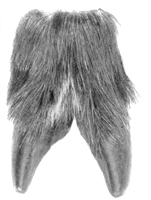Climbers Some adaptations are clearly habitat specific. They are not related to the alpine environment but can also be found in lowland species living in similar habitats.
Rock climbers have specially adaptated feet. The soles of the feet of the hyrax (Procavia capensis) which lives in the Ethiopian mountains are covered with a rubbery pad that secretes a sticky sweat, giving the hyrax an excellent grip as it climbs over the rocks.
In the European Alps, ibex (Capra ibex) and chamois (Rupicapra rupicapra) are typical climbers. The hooves of ibex and chamois have a hard, thin rim surrounding a soft, spongelike interior, enabling them to climb nearvertical cliffs and smooth, slick rock faces with equal ease. Moreover, the ibex can move the two toes independently. This allows it to depose each of its toes on another edge giving it enormous stability in the rocky habitat.
|

 a
a
 b
b
 c
c



